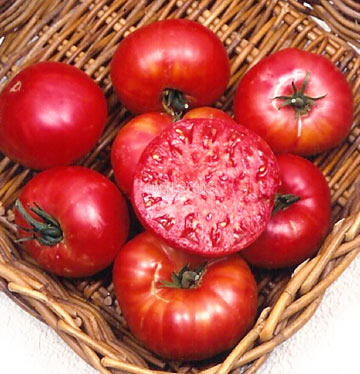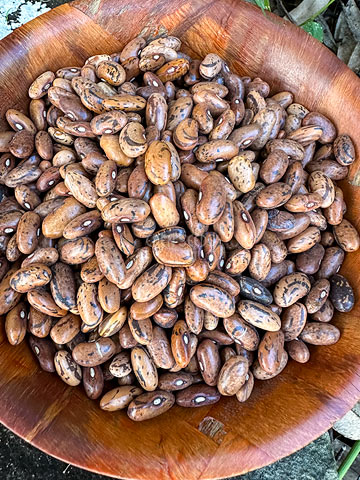Articles
American Heirlooms
This October, we're diving deep into the stories behind some of the most cherished heirloom varieties, with a special focus on American heirlooms. These seeds carry not just the promise of future harvests but the weight of generations past, preserved through careful stewardship. Whether it’s a bean passed down through Indigenous hands or a pumpkin grown for generations on family farms, each heirloom tells a story of resilience and connection.
As the Northern Hemisphere settles into autumn, thoughts turn to Halloween, harvest festivals, and the golden hues of falling leaves. It’s a time for gathering in the last of the season's bounty, carving pumpkins, and celebrating the close of another growing season. Meanwhile, here in the Southern Hemisphere, we’re welcoming spring in full bloom—our gardens are bursting to life, and we’re preparing for fresh plantings before the real heat hits. While one hemisphere savours the harvest, the other prepares for its abundance yet to come, both connected by the cycle of the seasons.
Before we get into the heirloom seeds we are celebrating this month,
Let's define what exactly IS an heirloom?
Heirloom seeds are defined by their historical significance and traditional cultivation methods. They are varieties that have been passed down through generations, often for 50 years or more, and are typically open-pollinated, meaning they are pollinated naturally by insects, birds, or the wind rather than through controlled hybridisation. This allows heirloom plants to maintain their unique traits and flavours over time and give you peace of mind that what you plant each season is going to turn out just like it's parent plant, and not something vastly unexpected. Heirloom seeds are valued for their genetic diversity, taste, and resilience, as they often adapt well to local growing conditions, making them a cherished choice for gardeners and farmers looking to preserve agricultural heritage.
Tomato

Mortgage Lifter Tomato: The story of Mortgage Lifter is as hearty as the tomato itself. This variety was bred in the 1930s by a gardener named M.C. "Radiator Charlie" Byles in West Virginia, who earned enough from selling his prized tomatoes to pay off his home mortgage—hence the name! He wasn't a professional plant breeder but rather a radiator repairman who crossed several of the largest tomato varieties he could find over six years. The resulting tomato was huge and delicious, and he sold enough seedlings to pay off his mortgage during the Great Depression, which is how the variety got its memorable name. Known for its large, meaty fruit and deliciously sweet flavour, it remains a favourite for home gardeners and tomato lovers alike. The Mortgage Lifter tomato has one of the most heartwarming stories in the heirloom world. His story of perseverance and ingenuity has been passed down through every Mortgage Lifter tomato seed, making it a living testament to the human spirit.
Wapsipinicon Peach Tomato: This unusual variety, named after the Wapsipinicon River in Iowa, produces small, fuzzy, peach-coloured tomatoes with a flavour that is both sweet and slightly tangy. The plants are prolific, offering abundant clusters of these unique tomatoes throughout the growing season, reminiscent of the days when flavour was prioritised over uniformity. Their skin has a soft, fuzzy texture, reminiscent of a peach, and they are perfect for snacking or adding to salads. The Wapsipinicon Peach Tomato is a rare heirloom, offering a delicious taste of the Midwest and a reminder of the diversity found within heirloom varieties.
Bean
Cherokee Trail of Tears Bean: Perhaps no heirloom seed carries as much historical weight as the Cherokee Trail of Tears bean. This resilient black bean was carried by the Cherokee people during their forced removal from their homelands in the 1830s, along what became known as the Trail of Tears. The journey was marked by immense hardship, but the bean survived, serving as both a food source and a link to their culture. Growing this bean in your garden is a way of honouring the endurance of the Cherokee people, while also enjoying a prolific, nutritious crop.
Rattlesnake Bean: This variety has an intriguing history rooted in North American agriculture. Named for the distinctive markings on its pods, which resemble the pattern of a rattlesnake’s skin, this heirloom variety is believed to have been cultivated by Indigenous peoples for centuries. Its exact origins are somewhat unclear, but it's often associated with the Appalachian region, where it has been passed down through generations of farmers.
Rattlesnake Beans are known for their adaptability to different growing conditions and their vigorous climbing habit, making them a popular choice for home gardens. They produce flat, green pods streaked with purple, and their tender, buttery flavour makes them a favourite for both fresh dishes and canning. As awareness of heirloom varieties has grown, the Rattlesnake Bean has seen a resurgence in popularity, celebrated not only for its unique appearance and taste but also as a symbol of agricultural heritage.
Blue Lake Bean: Boasting a rich agricultural history that traces back to the fertile fields of Oregon in the early 20th century. Originally bred in the Blue Lake district, it was first developed as a pole bean, prized for its tender, stringless pods and excellent flavour. Later, bush varieties of the Blue Lake were cultivated, making it more accessible to commercial growers and home gardeners alike. The bean gained popularity due to its adaptability, high yields, and ability to be harvested for both fresh eating and became very popular for canning, making it a staple in American gardens. Today, the Blue Lake Bean is celebrated for maintaining its heirloom characteristics while still being a reliable, productive variety for gardeners everywhere.
Corn
Oaxacan Green Corn: This heirloom corn, with its difficult to pronounce name and stunning green kernels, hails from the Indigenous Zapotec people of Oaxaca, Mexico. Oaxacan Green Corn was traditionally grown in the highlands, where its drought resistance made it essential for survival. The corn was ground into masa for tortillas and tamales, and its vivid green hue symbolised vitality and the richness of the earth. Growing this heirloom connects gardeners to centuries of Indigenous agricultural wisdom and the importance of sustainability.
By the way, the correct pronunciation is "wa-hah-kan".
Golden Bantam Corn: Introduced in 1902 by farmer William Chambers in the town of Concord, Massachusetts, Golden Bantam Corn holds a significant place in American agricultural history as one of the first widely grown sweet corn varieties. Chambers was searching for a corn that not only had exceptional taste but could also thrive in a variety of conditions. After years of selective breeding, he developed Golden Bantam, a semi-dwarf variety that produced shorter stalks but yielded sweet, tender ears packed with flavour.
The introduction of Golden Bantam revolutionised home gardening and altered the perception of sweet corn. Prior to its popularity, corn was primarily considered a staple food source often used for livestock feed or as a component in other dishes. However, with its rich, buttery flavour and sweet kernels, Golden Bantam made fresh corn on the cob a sought-after summer fresh produce treat for families across America.
Pumpkin
Waltham Butternut Pumpkin: The Waltham Butternut pumpkin is a more modern heirloom, developed in the 1940s in Waltham, Massachusetts. However, it’s rooted in a much older tradition of growing pumpkins as a versatile and nutritious staple food. Known for its sweet, nutty flavour and excellent storage properties, Waltham Butternut quickly became a household favourite. Its smooth, tan skin and deep orange flesh make it perfect for soups, roasting, and even desserts. For gardeners, it’s a reliable producer and a wonderful reminder of the agricultural innovations of the past century.
Pennsylvania Dutch Crookneck: The Pennsylvania Dutch Crookneck is a traditional heirloom pumpkin, prized for its sweet, rich flesh and excellent storage qualities. This variety was brought to America by early settlers, and it has been a staple in the Pennsylvania Dutch community for centuries. Its long, curved neck makes it easy to slice and offers an abundance of delicious, bright orange flesh, often used in pies and soups. It’s known for its smooth texture and nutty flavour, and its ability to store well into the winter months makes it a reliable and cherished food source for homesteaders and gardeners alike.
Cucumber

Lemon Cucumber: Not only a unique and delightful addition to any garden, but it also has a rich history that adds to its charm. This heirloom variety originated in the late 1800s, gaining popularity among home gardeners during the Victorian era. Its vibrant, round, lemon-yellow fruits stood out in gardens filled with more conventional green cucumbers, capturing the attention of gardeners who appreciated novelty and aesthetics in their vegetable plots.
In addition to its striking appearance, the Lemon Cucumber was celebrated for its crisp texture and mild flavour, which set it apart from other cucumber varieties. It quickly became a staple in summer salads and a refreshing snack, often enjoyed sliced and sprinkled with a bit of salt or added to sandwiches. The cucumber's unique taste and texture made it an ideal candidate for pickling, allowing it to shine in tangy brines and relishes that complemented summer picnics and barbecues.
Lettuce

Great Lakes Lettuce: has a fascinating background rooted in agricultural innovation. It was developed in the 1940s by plant breeders at the USDA and the University of California as the first successful iceberg-type lettuce for the commercial market. Its crisp, compact head made it ideal for shipping, and it quickly became popular with farmers due to its disease resistance and ability to tolerate warmer climates. This variety revolutionised the lettuce industry in the United States, setting the stage for the widespread adoption of iceberg lettuce in grocery stores and restaurants across the country.
Though modern hybrid versions have since been developed, the original Great Lakes Lettuce remains a favourite for home gardeners, prized for its robust growth and crisp texture.
A Living Connection to the Past
Growing heirloom seeds is about more than just cultivating vegetables—it's about preserving history, biodiversity, and flavour that can't be found in modern hybrids. These seeds are a link to the past, representing generations of careful cultivation, and when we plant them, we become stewards of that legacy. Whether you’re drawn to the history of Indigenous crops, the innovation of early gardeners, or simply want to grow delicious, unique vegetables, heirloom seeds offer a deep, meaningful connection to the earth and its rich agricultural history.
So, as we head into the height of spring here in the Southern Hemisphere, take a moment to reflect on the stories behind the seeds you plant. Just as the Northern Hemisphere celebrates the harvest season, we prepare for a new cycle of growth, bound together by the cycles of nature and the shared heritage of these incredible heirloom seeds.






